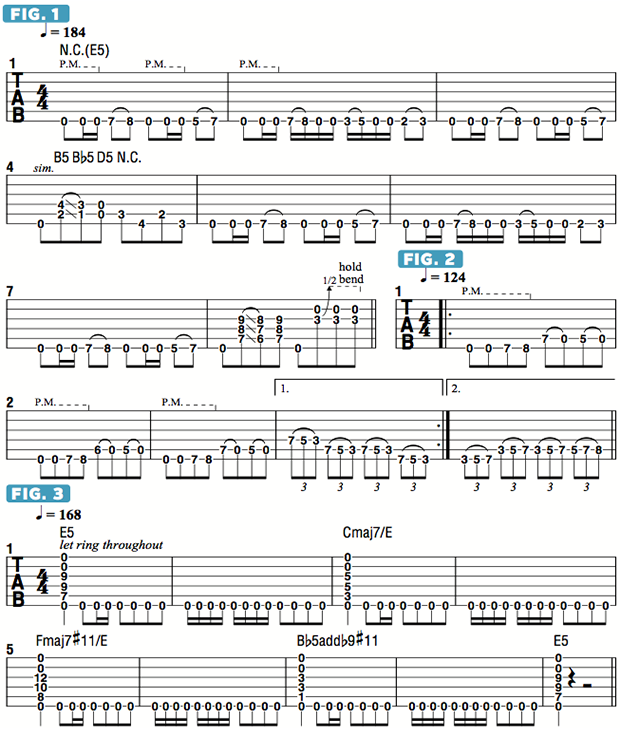How to Forge Aggressive, Memorable Riffs with Unexpected Twists
Whenever I am composing primary riffs for a metal song, one of my goals is to come up with something that not only sounds heavy but also takes the listener on some kind of journey to the unknown!
One effective way to create powerful music is to set up a groove and a riff or sequence, and just when the listener is settled into that groove, something will come along that twists it in an unexpected way.
This approach will keep the riffs sounding lively and the listener engaged and interested.
FIGURE 1 is a Pantera-inspired riff built from a repeating four-bar phrase that ends differently each time. In Pantera’s music, [guitarist] Dimebag Darrell and [drummer] Vinnie Paul would always set up these killer grooves, and then suddenly they’d introduce a bizarre and unexpected twist. This riff begins with a hard-driving line that’s played entirely on the low E string for the first three bars and built rhythmically from a combination of eighth and 16th notes.
Be sure to alternate (down-up) pick throughout the riff and palm mute all of the repeating open low E notes. The first twist comes in bar 4, initiated with a B5-Bb5 power chord slide followed by D5 chord sounded on the open fifth and fourth strings. I then add chromatically descending two-note shapes that outline Ab and G major chords.
This is a good example of how to use a chromatic shift to create an unusual and unexpected sound. The first three bars are then restated, and in bar 8 the entire figure wraps up with a chromatically sliding E(b5) shape followed by a bizarre unison bend on the G and B string, as Bb on the G string is bent up one half step to B, sounded along with the open B string. This unison bend from a half-step below adds a “snarl” to the riff that sounds really cool.
In FIGURE 2, I again begin the first two bars with a low-E pedal tone, followed by the fretted notes B and C across beats one and two, but I then follow these notes with pull-offs to the open A string, from E and D on bar 1 and from Eb and D in bar 2. Bar 3 is a restatement of bar 1, and then bar 4 features fast, descending eighth-note-triplet pull-offs on the bottom three strings. This run requires a wide stretch, so keep your fret hand relaxed and your fingers positioned directly above the fretboard. The first four bars then repeat, and in the second ending, the eighth-note triplets now ascend, starting on the sixth string and moving over to the fifth.
FIGURE 3 is a simpler pattern built from a succession of four chords that are sustained over a repeating low-E pedal tone. Each chord is fretted on the A, D and G strings along with the open B and high E. I begin with E5 and then move the shape down two whole steps to C5. The third chord is a very unusual—and great sounding—Fmaj7#11 played against the E bass note, followed by Bb5, filled out with the inclusion of the open B and high E strings.
The basic idea with each of these figures is to strategically place ear-catching parts in unexpected places to give the music a unique flavor and an element of surprise. Try this approach in our own riff writing!

Get The Pick Newsletter
All the latest guitar news, interviews, lessons, reviews, deals and more, direct to your inbox!
“There are so many sounds to be discovered when you get away from using a pick”: Jared James Nichols shows you how to add “snap, crackle and pop” to your playing with banjo rolls and string snaps
Don't let chord inversions bamboozle you. It's simply the case of shuffling the notes around
